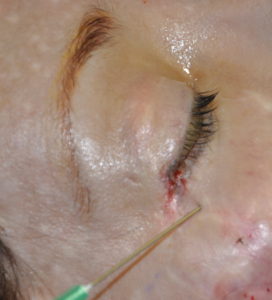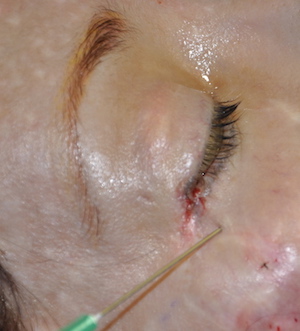Injection fat grafting is used all over the face to treat a wide variety of soft tissue, and sometimes hard tissue, contour deformities. Its advantages are that it is an autologous material that can be applied without open surgery through small bore cannulas. Its disadvantages are that the injected fat survival is not assured and, between the survival issue and the non-linear flow method of injection, contour irregularities (lumps) may result.

In the January 2020 issue of the journal Aesthetic Plastic Surgery, an article was published entitled ‘Properly Diluted Fat (PDF): An Easy and Safe Approach to Periocular Fat Grafting.’ In this paper the authors performed a retrospective study of two hundred (200) patients who had periocular fat grafting by injection. Their method eyelid fat grafting consisted of: 1) fat aspiration using small multiple cannulas, 2) aspirate concentration by centrifugation, and 30 an injection solution prepared with 70% fat mixed with saline and infratant fluid. The diluted fat solution was injected by 1.2mm single hole cannulas after pre-tunneling. The long term results were assessed by before and after pictures.
Most of the patients presented for followup at six months after the procedure (164, 82%) while these less half (83, 42%) presented for one year followup. They observed that all patents had improvement in eyelid contours but with variable amounts of value loss. The most notable improvement occurred in patients who had pre-treatment scleral show, many of which had less afterwards. At one year after the procedure, Three patients (3, 7%) had eyelid contour irregularities evidenced by bulges. Two patients (2, 5%) due to weight gain showed excess fat accumulation.
This diluted type of fat injection to the eyelids produced a fairly low incidence of postoperative contour problems in those able to be seen in long term followup. (5 patients, 12%) It is clear that thick heavily concentrated fat, while perhaps being better for improved survival, is not worth the risk of the contour irregularities that may result. Even with diluted fat an approximate 10% contour problem occurred.
Whether this method of creating an injectable fat solution is ideal for eyelid fat grafting is unknown. But mixing concentrated fat with the more liquid extraction (infranatant) left over after concentration seems logical.
Dr. Barry Eppley
Indianapolis, Indianapolis



